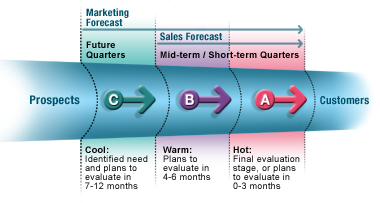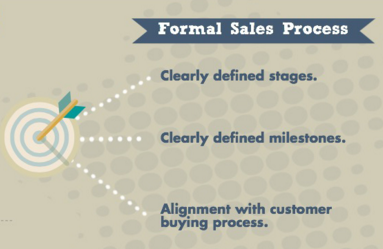You are viewing our site as a Broker, Switch Your View:
Agent | Broker Reset Filters to Default Back to List3 Steps to a Faster Moving Sales Pipeline
April 03 2016
Creating an efficient sales pipeline allows you to analyze who's moving through your pipeline and what it looks like, as well as to find the best way for you to get those prospects moving through it in a way that makes sense to you and your process. A sales pipeline is systematic approach to understanding your sales process and where the 'money' currently is.

Think of it as the journey your clients or customers take from becoming a prospect to following through on the sale with you. Some representations may show the pipeline as a funnel, others depict it as a forward moving, linear chart, but there's no right or wrong here; it's whatever makes the most sense to you and your business. So how can you activate your sales pipeline and start converting more prospects? We'll walk you through that, and go over the best metrics for you to track to become more efficient.
The bottom line here is that the sales pipeline that works for you may not always work for someone else in your field, let alone one of your co-workers. It's a fairly personalized experience and, at the end of the day, the pipeline is there for you to get a grasp on what's coming up, or who you may need to spend some time with in order to activate them or get them moving. While some larger companies and corporations have a uniform sales pipeline across the whole team, as a solo practitioner or member of a small team, you may find yourself working to create your own pipeline in a more personal manner.
But before you do so, understand these three steps as a way of establishing your pipeline and maintaining its effectiveness to start activating all of the sales.
1. Define your process and stages
Consider establishing your pipeline as a form of stage management. You want to understand exactly what each stage looks like and define how someone would move from one stage to the next. You need to know what goal your prospect must achieve if they are to move on to the next stage and exactly what that progression looks like.
Here's where MECE comes in handy. MECE, or Mutually Exclusive, Collectively Exhaustive (pronounced me-see) is a fun acronym that packs a punch.
Think about it this way—your pipeline must capture all stages of your sales cycle (collectively exhaustive), but at the same time your prospects or clients moving through the pipeline cannot belong in two stages at once (mutually exclusive). It's a great way to ensure that you have an organized way of understanding your pipeline and how prospects move through it, but it also almost completely guarantees that no one will get stuck in a stage or get placed in two stages at the same time.
Keep these stages simple because, often, less is far better than more in your pipeline. When you've got a pipeline with a dozen stages, chances are you're going to spend way too much time shifting and shuffling people around than doing any actual work. If you have two stages in your pipeline with the same end goal, you can probably consolidate them and save yourself a clogged pipeline.
2. Automate when you can
While we would never recommend cutting out personalization or the opportunity to build genuine relationships with your prospects or clients, we do say that automation can greatly assist you in being efficient.
This automation can mean everything from utilizing a software that tracks your sales prospects through your pipeline, or a CRM that automates the emails your prospect receives as they cross from one stage to the next. However, some small type of automation is bound to save you a lot of time and energy in the long run.
Take a look at your pipeline and understand where you can go a little hands-off. Granted, there's no technology that can make your phone calls for you (yet), but automation within reason will take a lot off of your plate.

3. Dedicate time to manage
No, this isn't an everyday check-in on your pipeline. It's more like a pulse check at least once a month where you make sure you've got a cleaned up pipeline and that no one's falling through the cracks or clogging everything up.
More often than not, a sales team or professional needs to understand whether they're going to hit their quota for the month. While this is more applicable to dedicated sales professionals, it doesn't hurt to understand where your revenue will be coming from that month. With a clean pipeline, you can easily take a look at where prospects are and determine their progression in your timeline based on that location.
Taking this time to look over your pipeline is also a great reminder as to why maintaining a clean and efficient pipeline is so important. Not understanding the necessity of the sales pipeline is the quickest way to let it fall by the wayside.
Plus, taking management time allows you to move your prospects and clients through the pipeline in real time. Be fully aware that getting to the goal of moving to the next stage may look different for different clients. Rather than recreating the movement between stages, doing it in the moment is far more effective and makes it less likely that you'll leave someone forgotten in the wrong stage. Companies or individuals who have mastered the art of pipeline management have grown 15% more and have 18% more revenue growth than those with ineffective or stagnant pipelines. Isn't that convincing enough to start managing your pipeline?
Keep it clean
With all the sales, pipeline, and CRM programs out there, you're bound to find the right fit for you and your business that allows you to better track your sales cycle and prospects moving through the pipeline. The idea here to is to find the ideal balance between automation and pipeline management that moves your prospects through the cycle efficiently, while still maintaining your personal touch.
Just remember MECE and the art of keeping your cycles clear and defined, leaving no room for confusing overlap and prospects getting lost within your pipeline.
To view the original article, visit the Contactually blog.









